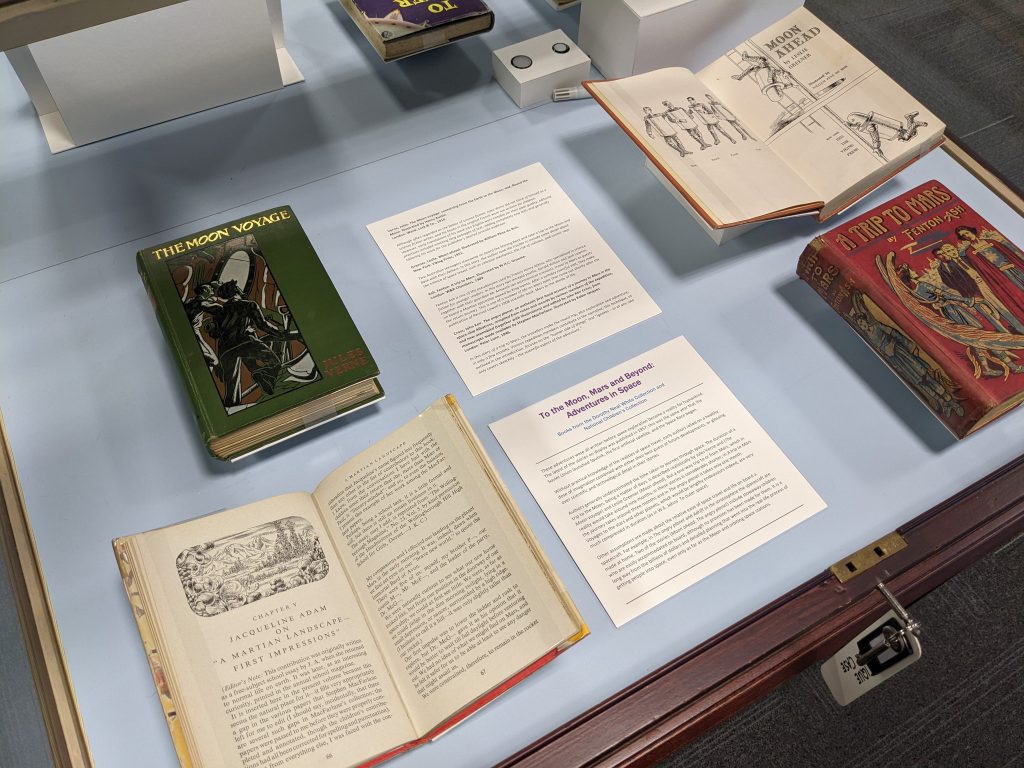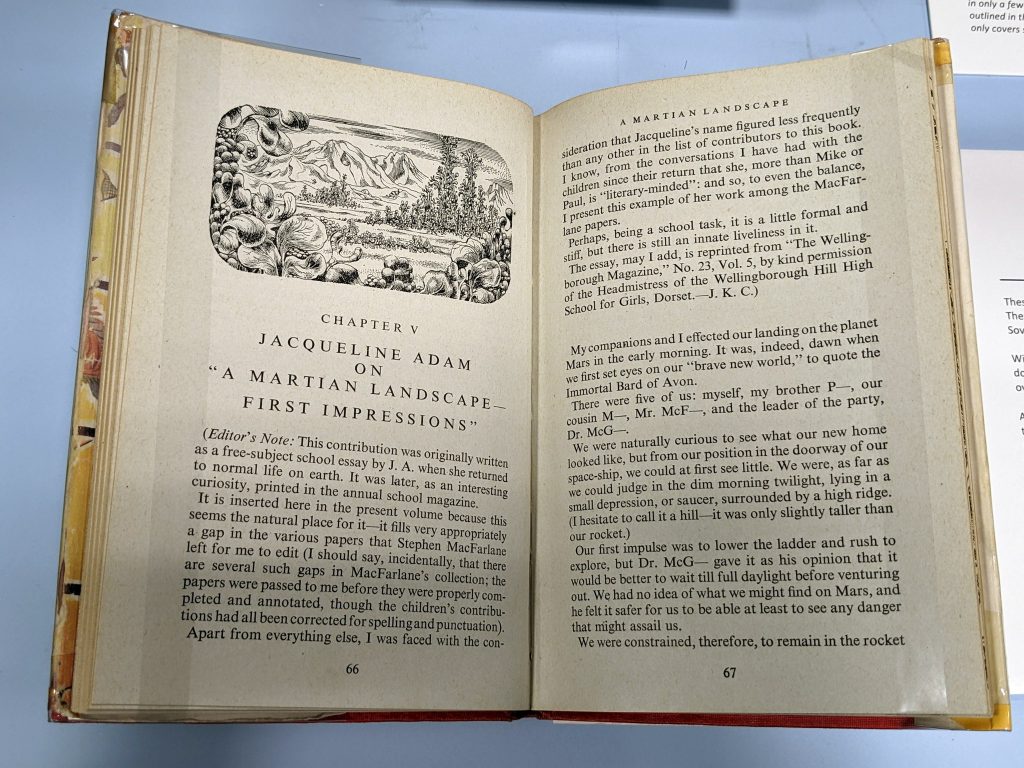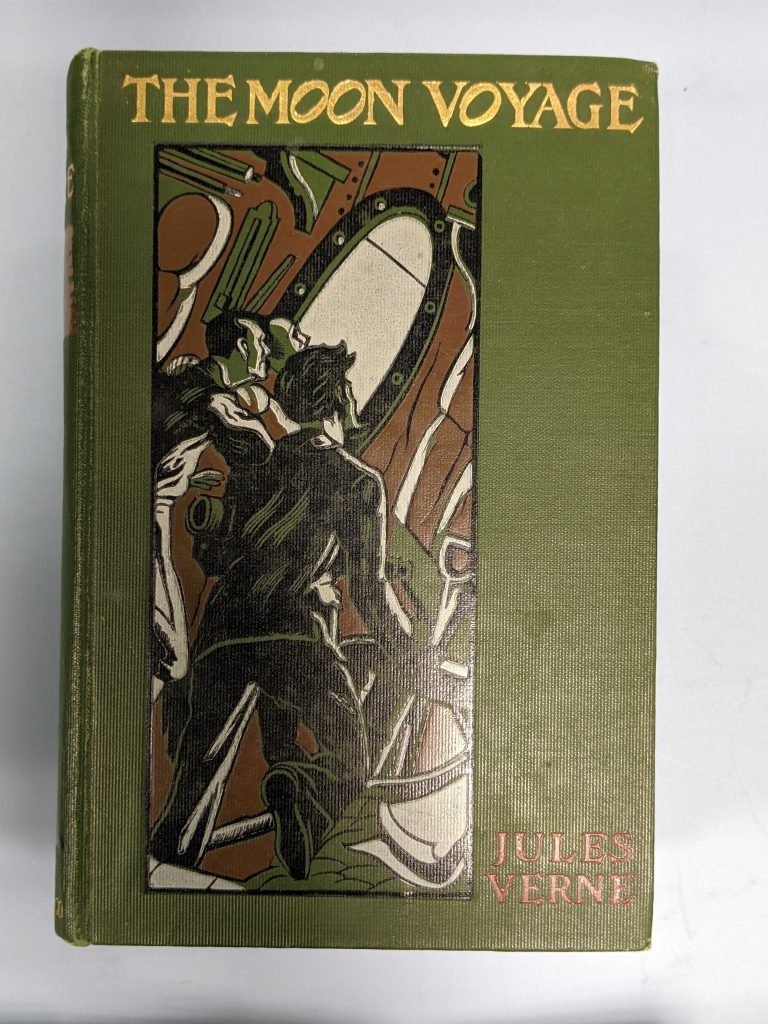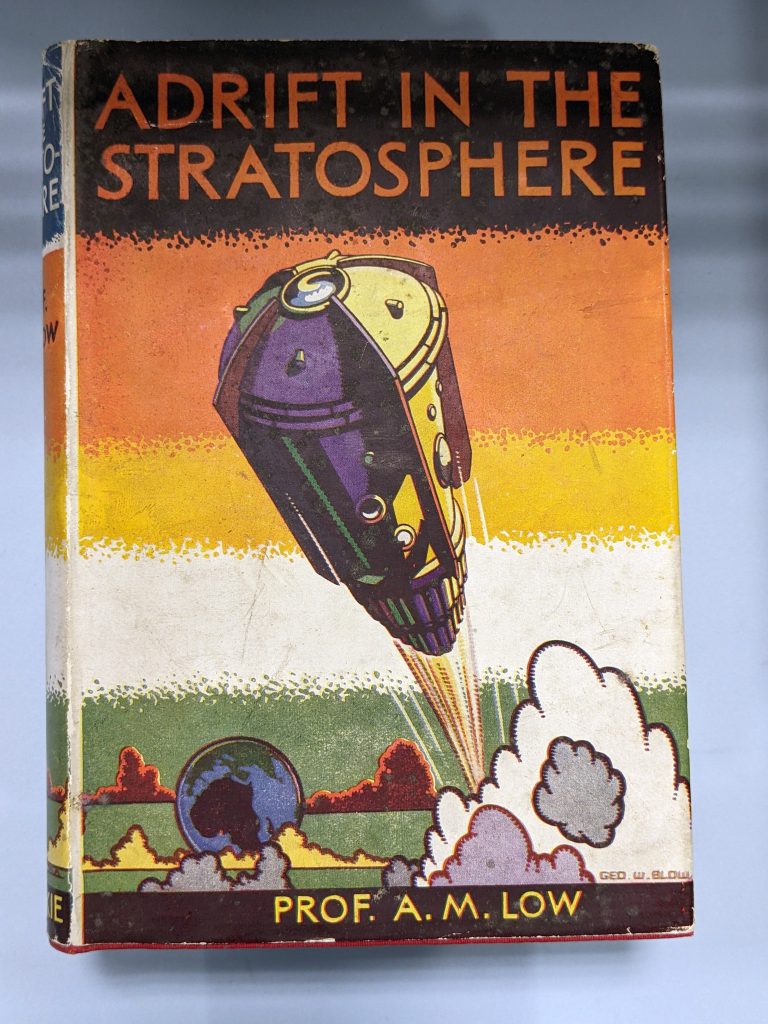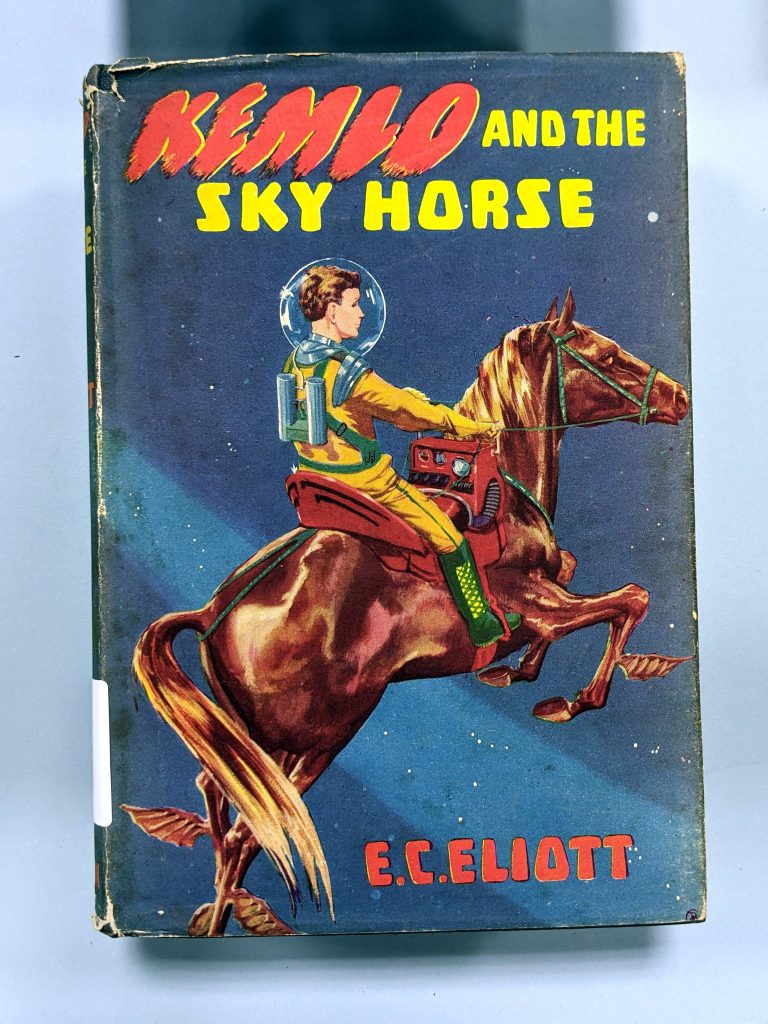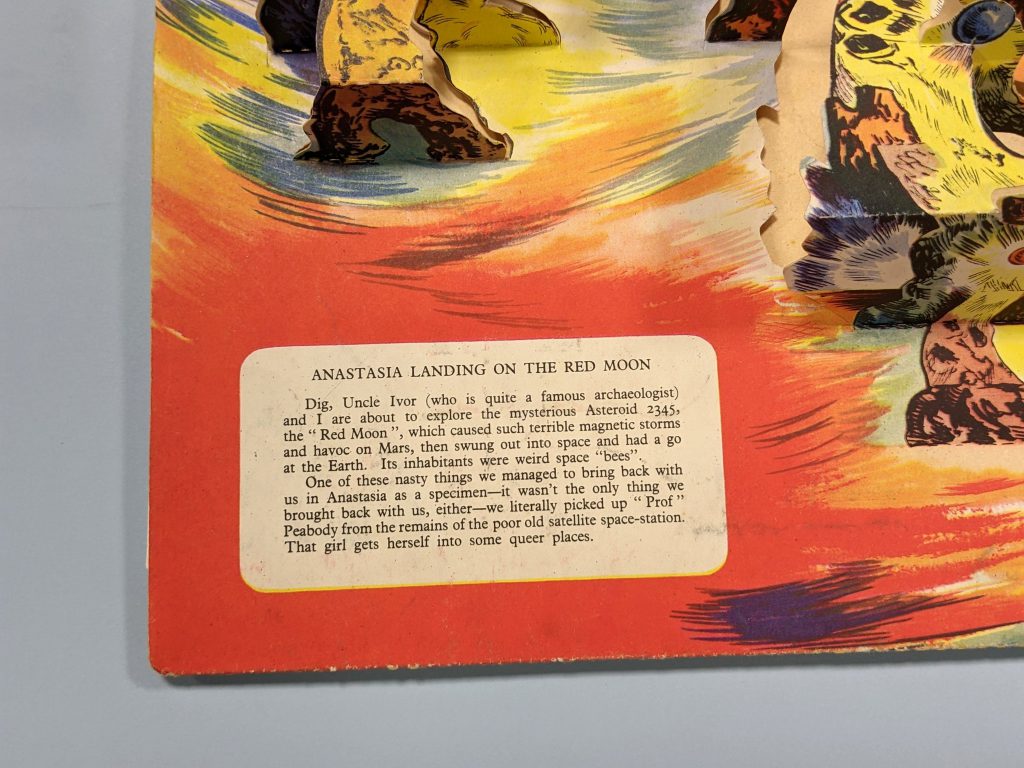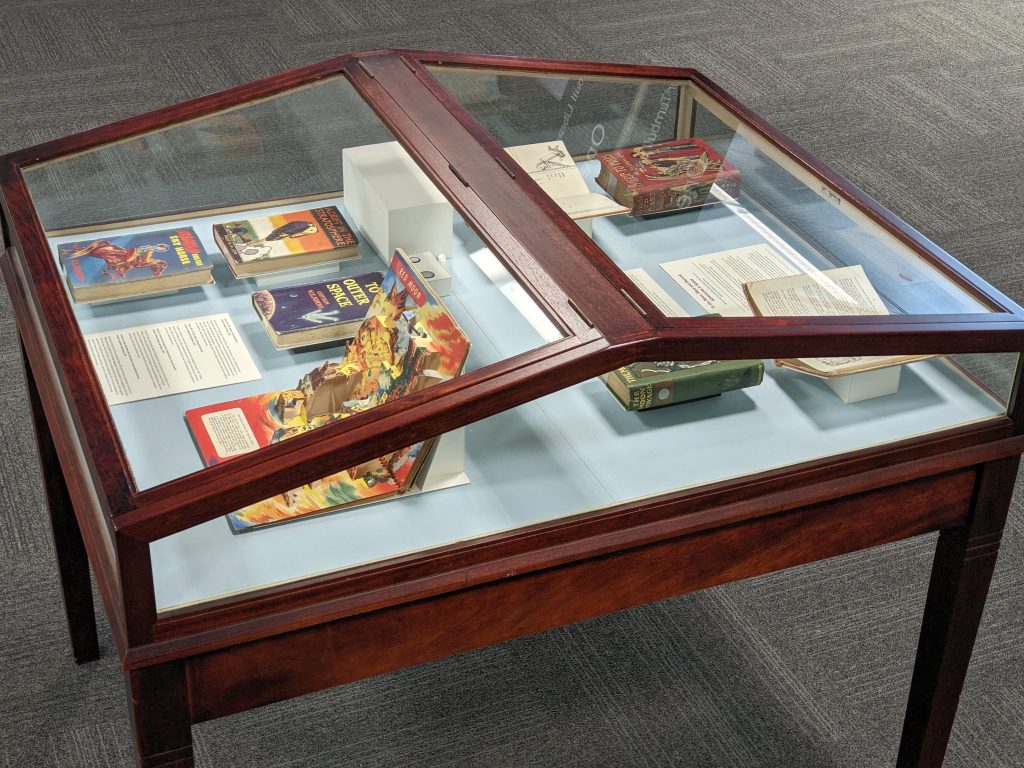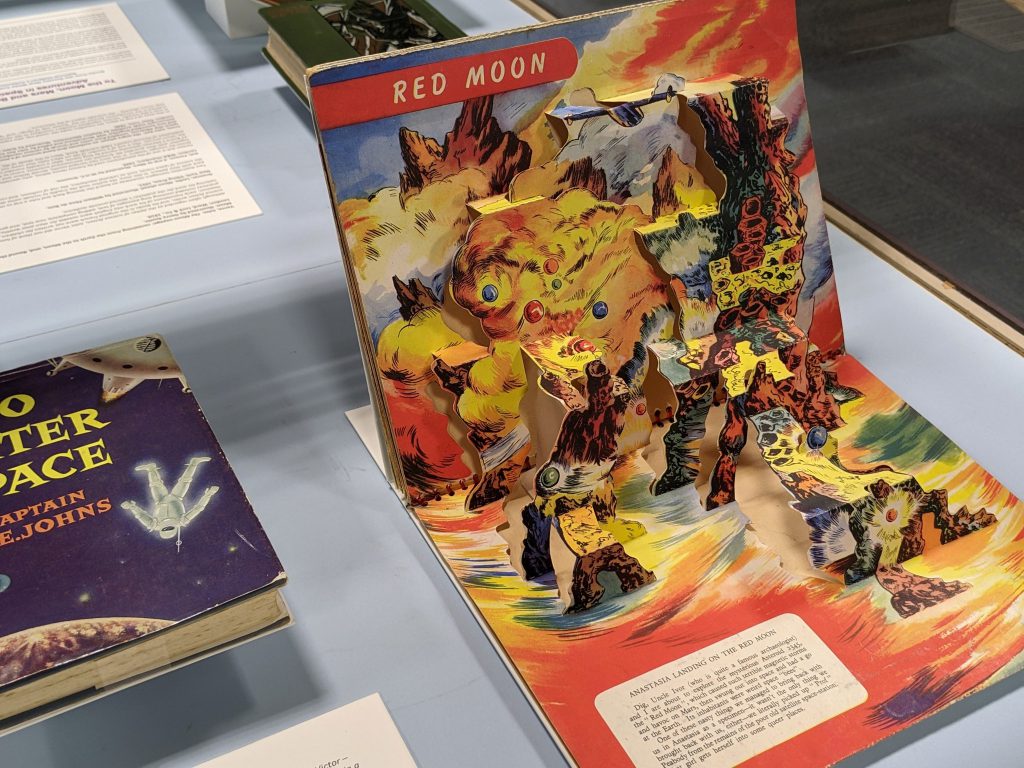To the Moon, Mars and Beyond:
Adventures in Space. Books from the Dorothy Neal White Collection and
National Children’s Collection. On display outside the Turnbull Library Reading Rooms on level of the National Library in Wellingto
Right click the image and choose – Open in a new Tab for a full image. Captions at bottom of page.
These adventures were all written before space exploration became a reality for humankind. The latest of the stories on display was published in 1957; this was the same year that the Soviet Union launched Sputnik, the first artificial satellite, and the Space Race began.Without practical knowledge of the realities of space travel, early authors relied on a healthy dose of imagination combined with either their best guess at future developments, or glossing over scientific and technological detail in their stories. Authors generally underestimated the time taken to journey through space. The duration of a trip to the Moon, being a matter of days, is described realistically by Jules Verne and (The Moon-voyage) and Leslie Greener (Moon ahead). But a one-way trip to or from Mars, which in reality would take around nine months, in these stories is considerably shorter; in A trip to Mars the journey takes around three months and in The angry planet it takes only one month. Voyages to the stars and other planets, which would be lengthy endeavours indeed, are very much compressed in duration (as in W.E. Johns’ To outer space). Other assumptions are made about the relative ease of space travel and life on board a spacecraft. For example, in The angry planet and Adrift in the stratosphere the spacecraft are made at home. Two of the stories (Moon ahead; The angry planet) include stowaway children who are easily accommodated on board, although no provision has been made for them. It is a long way from the billions of dollars and detailed planning that went into the real-life process of getting people into space, even only as far as the Moon and orbiting space stations.— Mary Skarott, Research Librarian, Children’s Literature
Images left to right, top to bottom.
1.To the Moon, Mars and Beyond:
Adventures in Space. Books from the Dorothy Neal White Collection and
National Children’s Collection. On display outside the Turnbull Library Reading Rooms on level of the National Library in Wellington.
2.The fourth volume in a ten-book series about the space voyages of Timothy “Tiger” Clinton (formerly of the RAF), his son Rex, scientist and inventor Professor Lucius Brane, and Brane’s butler Judkins. In this story the adventurers travel to new worlds beyond our solar system and run into an interplanetary war.
Johns, W.E. To outer space. Illustrated by Stead.
London: Hodder & Stoughton, 1957.
3. In this story of a trip to Mars, the travellers make the round trip, plus exploration and adventure, in only a few months. Various expedition members contribute to the narrative; this technique, as outlined in the introduction, focuses on the “human side of things” and “ignores – or at any rate only covers sketchily – the scientific aspect of the adventure.”
Cross, John Keir. The angry planet: an authentic first-hand account of a journey to Mars in the space-ship Albatross, compiled from notes and records by various members of the expedition, and now assembled (together with illustrations) and edited by John Keir Cross, from manuscripts made available by Stephen MacFarlane. Illustrated by Robin Jacques.
London: Peter Lunn, 1946.
4. Fenton Ash is one of the pseudonyms used by Francis Henry Atkins, who specialised in science fiction for younger readers. In this story two intrepid youths, Gerald Wilton and Jack Lawton, together with their guardian Mr Armeath (an astronomical scientist), travel to Mars as guests on board a Martian spaceship owned by King Ivanta. After a suitably eventful visit, they make the return journey. This is one of a number of life-on-Mars tales that came out shortly after the publication of Percival Lowell’s 1908 scientific book, Mars as the abode of life.
Ash, Fenton. A trip to Mars. Illustrated by W.H.C. Groome.
London: W&R Chambers, 1909.
5,Although often regarded as the father of science fiction, Jules Verne did not think of himself as a science fiction writer, and his books in the original French were not written for children. However, early translations of his work into English were notable for their poor quality; editorial practices included omitting long passages of text, adding completely new text, and generally tailoring his work for the publisher’s desired juvenile audience.
Verne, Jules. The Moon-voyage: containing From the Earth to the Moon, and, Round the Moon. Illustrated by Henry Austin.
London: Ward, Lock & Co., 1910.
6. Two Australian teenagers stowaway on board the Shining Rock and take a trip to the Moon and back with their fathers. In this story, the author took the trouble to include some detail about the science of space travel, such as celestial mechanics, the risk of collision, and cosmic rays.
Greener, Leslie. Moon ahead. Illustrated by William Pène du Bois.
New York: Viking Press, 1951.
7. Here the term “stratosphere” includes outer space. Three boys – Peter, Phillip and Victor – accidentally take off in the Aeronauticus, a home-built spaceship that they come across in a shed. The craft has some very advanced features, including an external viewing camera and a radio that can translate alien languages. They learn to operate the Aeronauticus as they go along and, after a series of incredible adventures that includes encounters with several different alien lifeforms, they make it safely home.
Low, Prof. A.M. Adrift in the stratosphere.
London: Blackie & Son, 1937.
8. Kemlo was born on the space station Satellite Belt K, one of a group of similar stations. He is a Captain in the Space Scouts and has his own two-seater space craft (or “scooter”) to travel around the Satellite Belts. In this story (one of 15 books in a series published between 1954 and 1963), Kemlo and the other troop leaders help their science engineering master to develop a mechanical horse that can gallop in space.
Eliott, E.C. Kemlo and the sky horse. Illustrated by A. Bruce Cornwell.
London: Thomas Nelson and Sons, 1954.
9. Hampson, Frank. Dan Dare: pilot of the future: in pop-up action pictures.
London: Juvenile Productions, 195-
10. The Turnbull Library display case for the Friends of the Dorothy Neal White Collection.
11. Dan Dare is chief pilot of the Interplanet Space Fleet and his heroic adventures, set in the late 1990s, were first published in the Eagle magazine. This pop-up book is an adaptation of the first Dan Dare story, Pilot of the future, written and illustrated by Frank Hampson, which originally appeared in the Eagle from April 1950 through to September 1951. The story introduces the reader to some of Dan’s friends, and others, and tells in flashbacks some of their many adventures in various planets and in space.
Hampson, Frank. Dan Dare: pilot of the future: in pop-up action pictures.
London: Juvenile Productions, 195-
